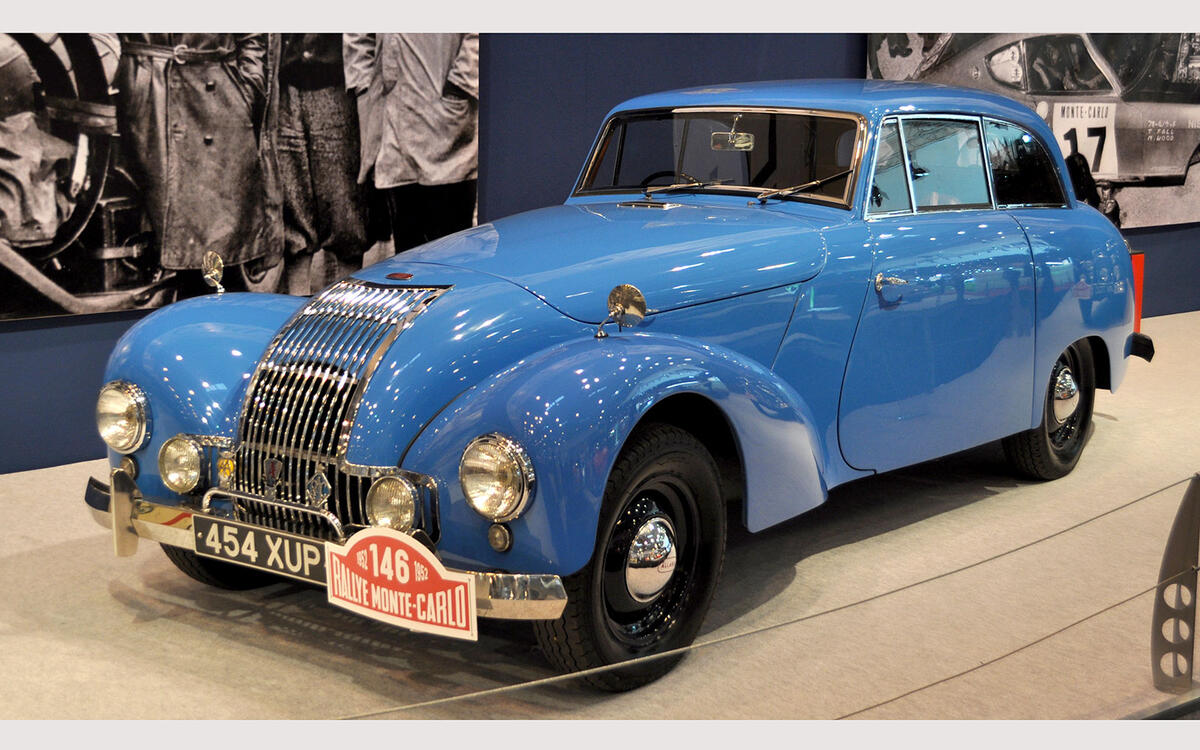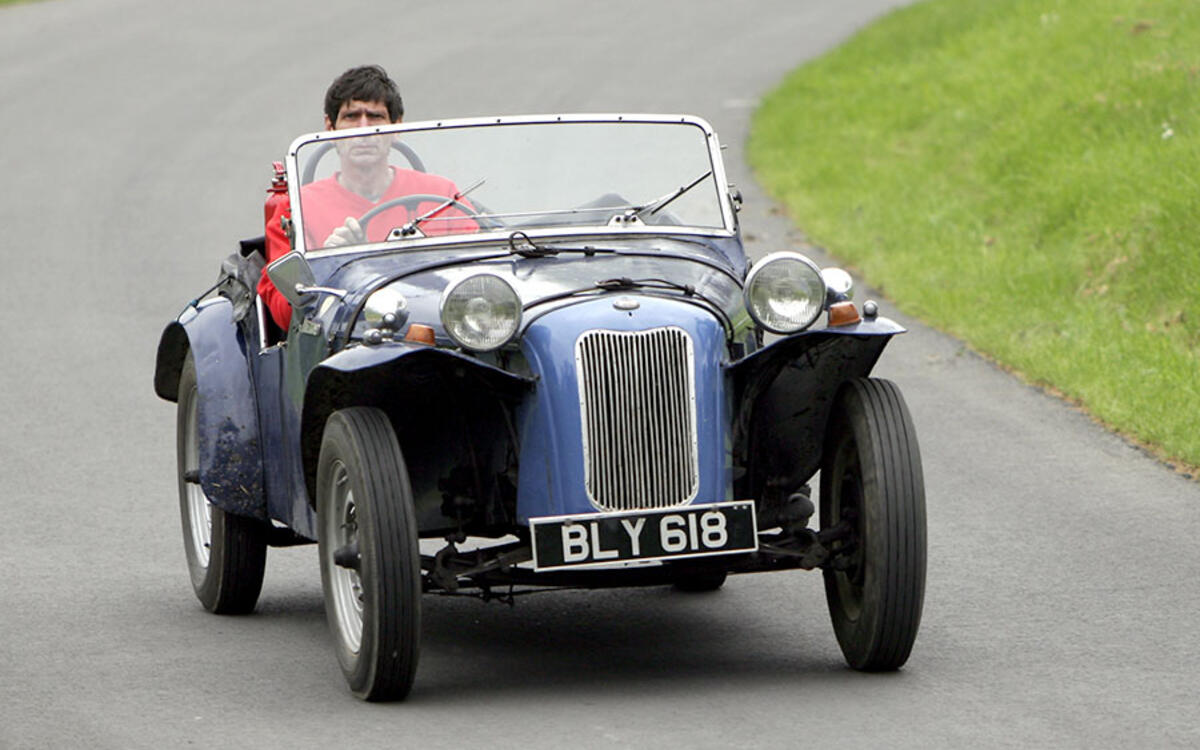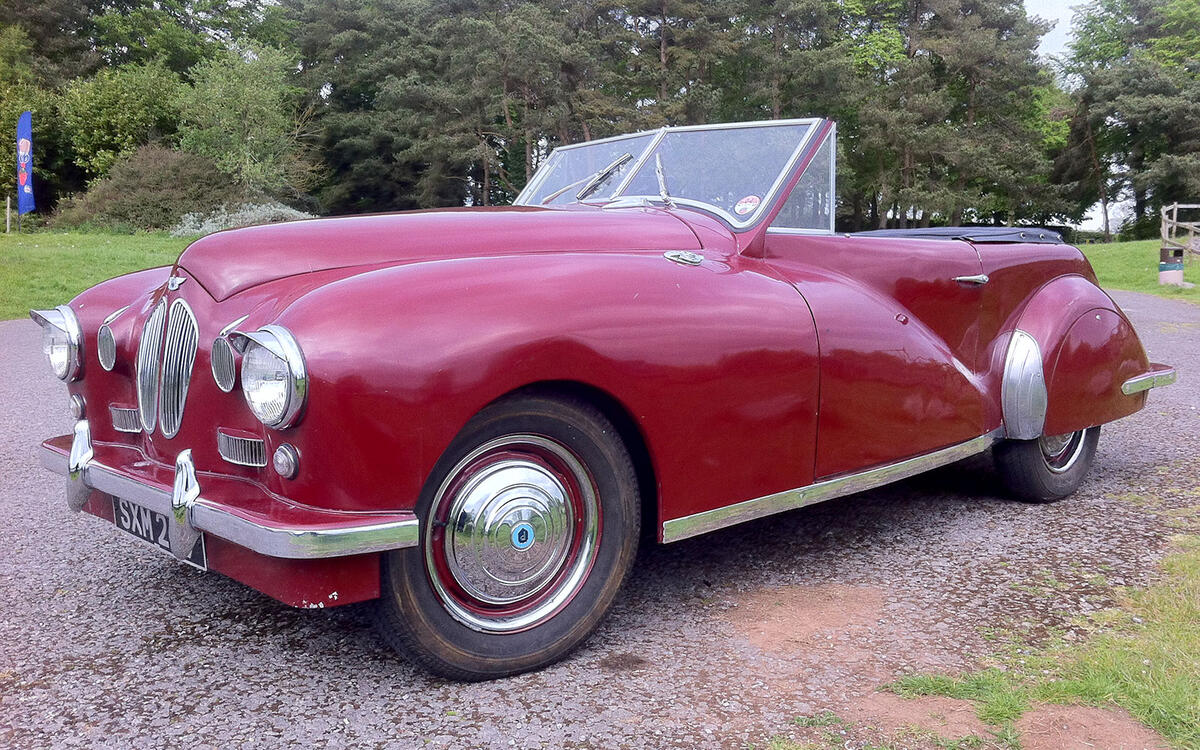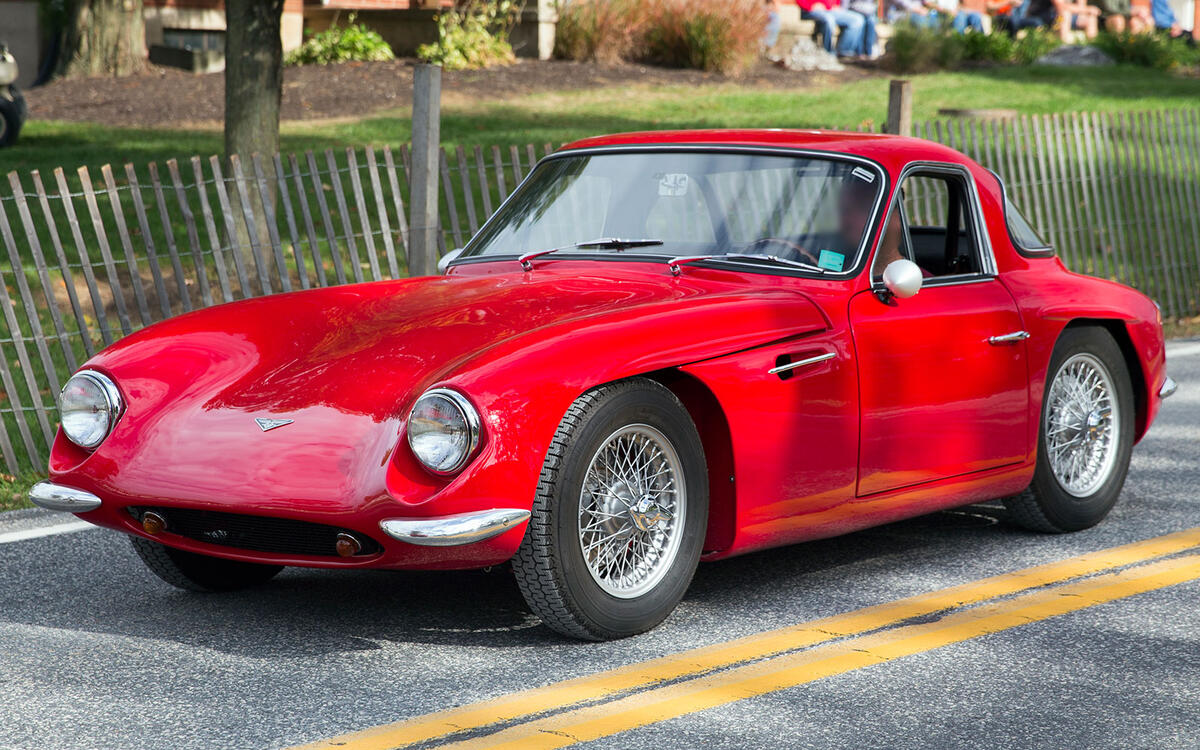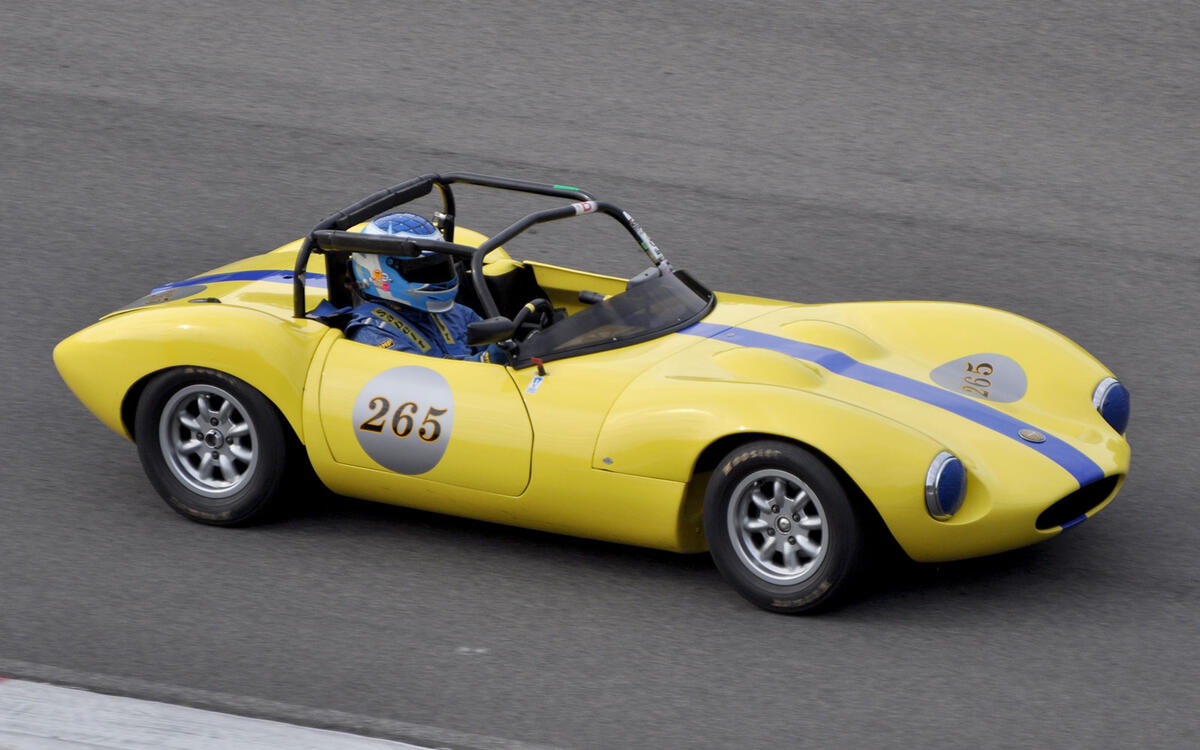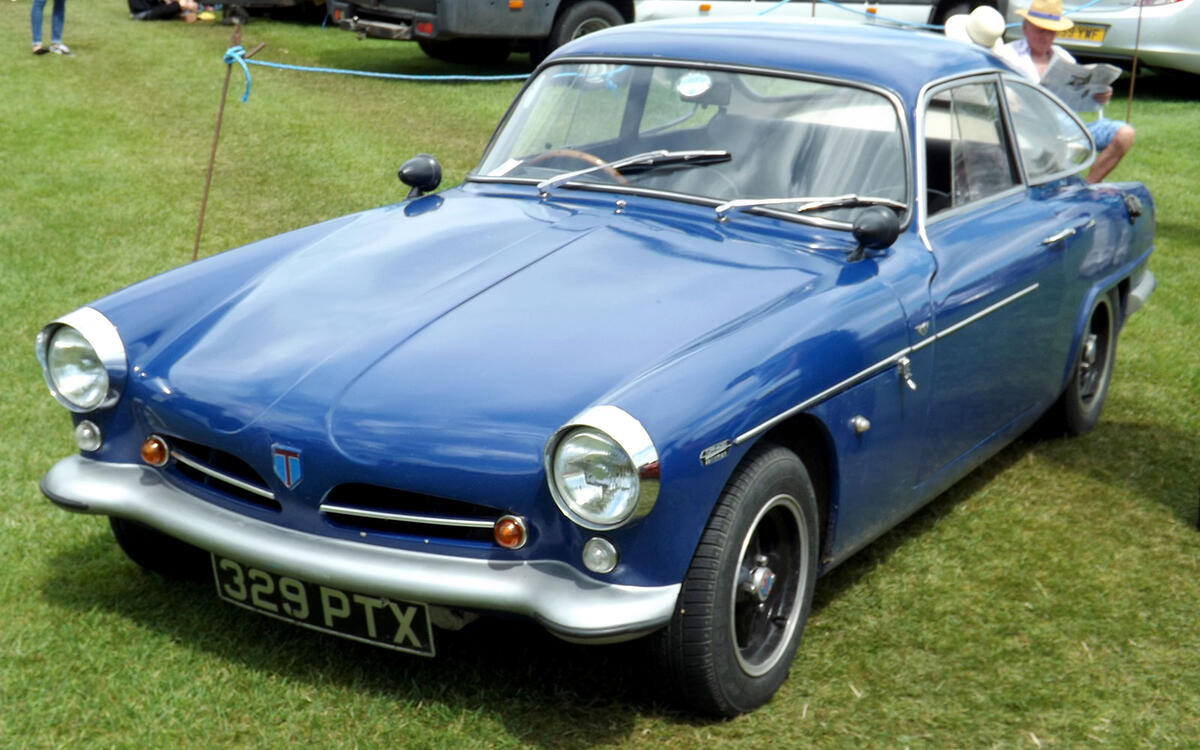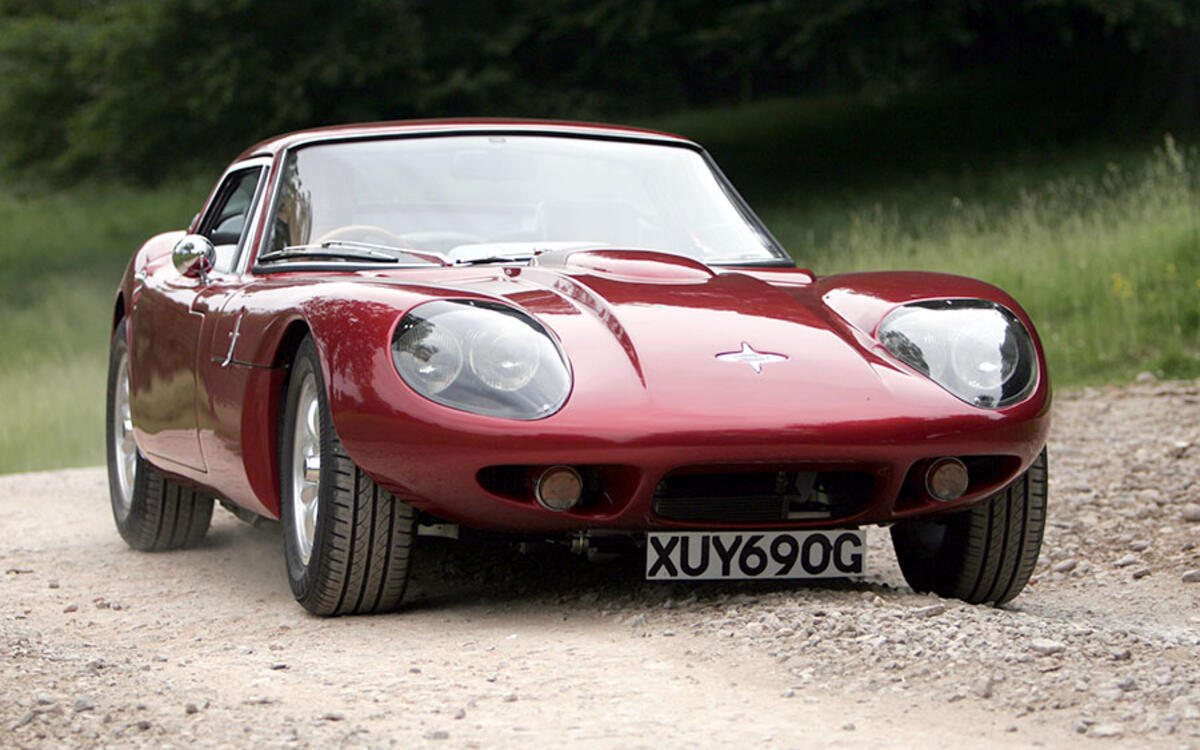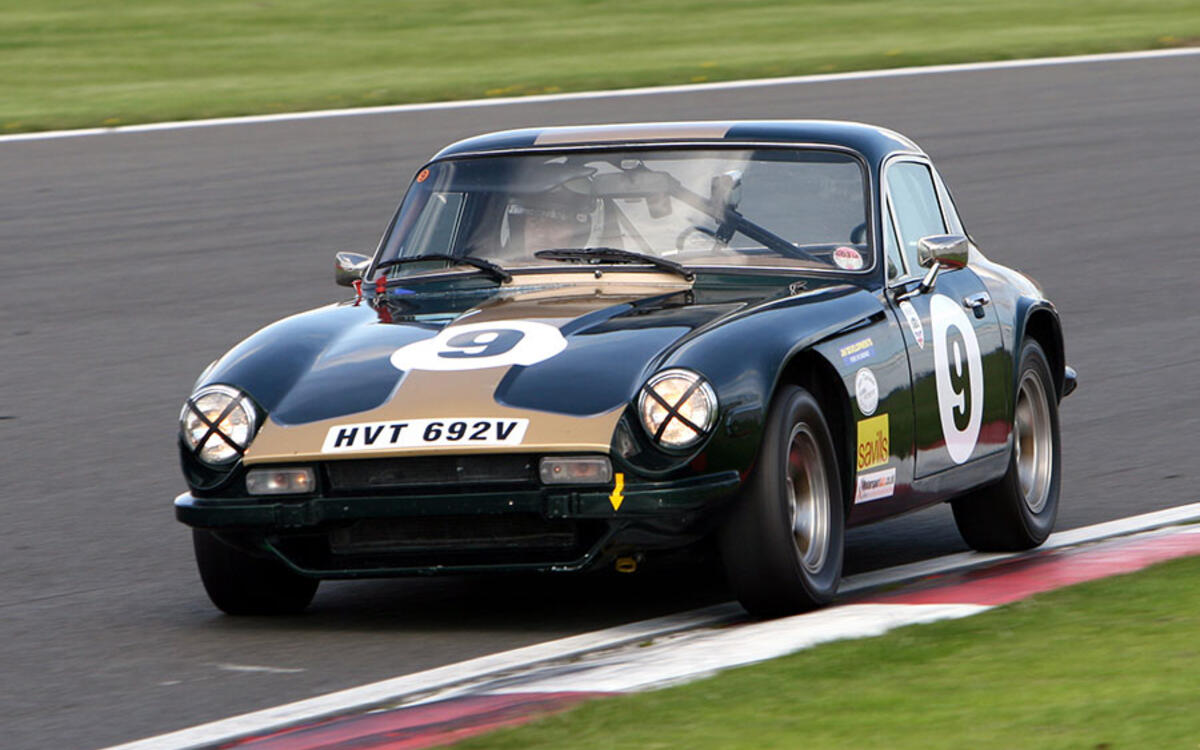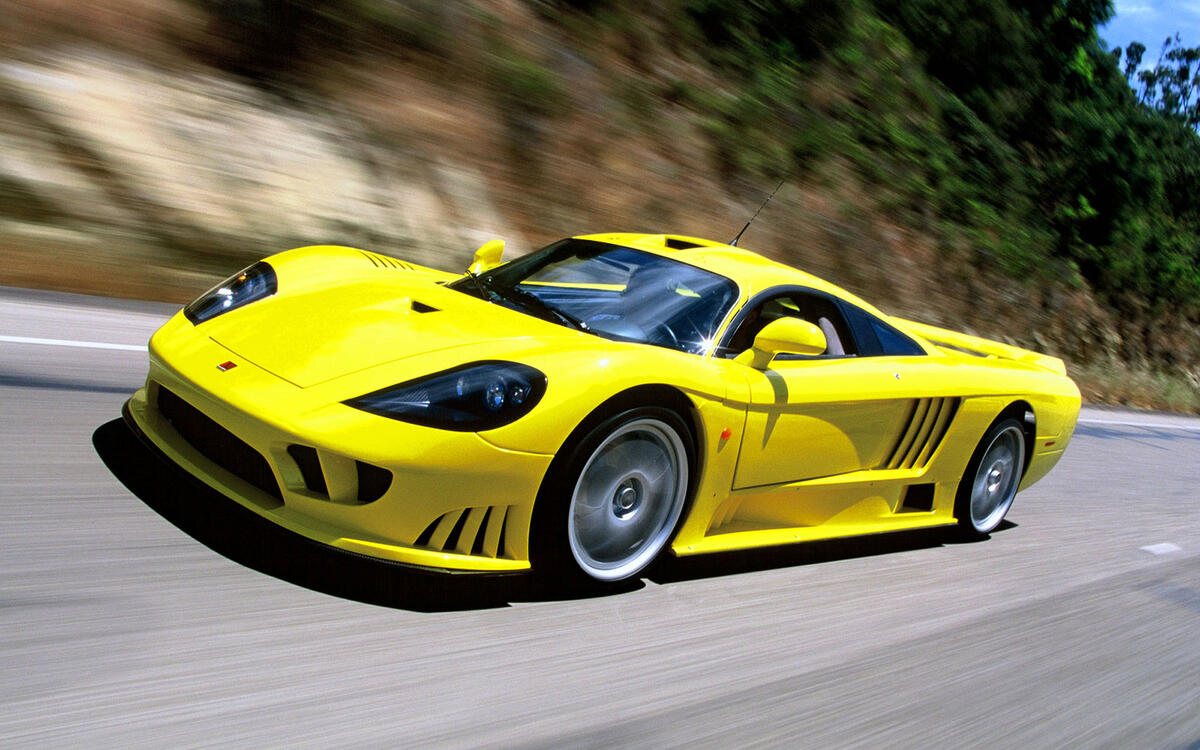 Slide of
Slide of
Think you know your Fords?
Well feast your eyes on this lot – all feature Ford engines, but without a blue oval in sight.
Ever since Henry Ford built his first vehicle in 1903, his company has been a major player in the global car market. But as well as a vast array of models produced over the years wearing Ford badges, Ford engines have provided the motive power for a massive number of specialist (and mainstream) cars - many British thanks to our unique specialist car industry.
Here we present 50 of the greatest cars to feature Ford power, both mainstream and obscure:
 Slide of
Slide of
Allard P1 (1948)
Londoner Sydney Allard (1910-1966) started building cars in 1946, starting with the J1 which featured a 3.9-litre Mercury flathead motor. Over the next 13 years Allard would build a variety of cars, virtually all of which were fitted with V8 engines - often from Ford. The company's biggest seller was the P1 (pictured), with a choice of 3622cc or 4375cc V8s; over four years 559 examples were made.
 Slide of
Slide of
Buckler (1949)
Another Londoner, Derek Buckler (1910-1964), is credited with founding the kit car industry with his Mark V (there was no Mark I-IV). He provided a well-made spaceframe chassis and aluminium bodies (later cars got glassfibre panelwork), into which enthusiasts could slot their Ford running gear.
This typically meant a 1172cc side-valve engine from a Ford Prefect E93A, with the associated gearbox, brakes and suspension. Production lasted right the way through until 1962.
 Slide of
Slide of
Paramount (1950)
In the post-war years a huge number of tiny companies sprang up to sell their wares. These were invariably low-tech sporting models with the Paramount being a fairly typical example. With its separate chassis and traditional construction, the Paramount couldn't compete with more mainstream rivals which had far greater economies of scale, and production folded after just 70 or so cars had been built.
At first a Ford 1172cc side-valve engine was fitted, then from 1953 a 1508cc unit was used.
 Slide of
Slide of
AC Ace (1953)
The Ace was a curvaceous aluminium-bodied sports car that arrived in 1953 with AC's own 1991cc six-cylinder engine, then from 1956 it was offered with a 1971cc Bristol straight-six powerplant. But by the early 1960s Bristol was moving away from its own engines, and the answer for AC was to fit a tuned Ford Zephyr 2553cc straight-six which eked out Ace production until 1963.
 Slide of
Slide of
Morgan 4/4 (1955)
Morgan introduced the 4/4 in 1936 and it's still in production with a Ford Sigma engine. It wasn't until the arrival of the 'cowled radiator' 4/4 in 1955 that Morgan adopted Ford power. And while the car hasn't been offered continuously since 1955, when it has it's generally been with engines from the Blue Oval.
 Slide of
Slide of
Lotus Seven (1957)
The Seven was the original – and some would say best – lightweight sports car, Lotus Six notwithstanding, and the car that launched a thousand replicas. With its multi-tube chassis, coil spring independent front suspension, plus rack-and-pinion steering - the Seven was a marvel. There would be four distinct series, all of which were offered with engines from the Ford parts bin – along with other manufacturers.
 Slide of
Slide of
Elva Courier (1958)
There were four iterations of the Elva Courier, a make which burst on to the scene in 1958, taking its name from the French for 'she goes' – Elle Va!
Pitched against the MGA and then the MGB (the latter arrived in 1962), the Courier was offered with all sorts of engines and transmissions, including a Ford Cortina GT powerplant with its associated four-speed manual gearbox.
 Slide of
Slide of
Tornado Typhoon (1958)
Tornado started out as a company that made glassfibre components, and by 1958 its first car was on sale: the Typhoon. Buyers could opt for just the chassis, just the body, or both, with a variety of wheelbases and mechanical configurations possible. Almost 400 Typhoons were made, most powered by Ford's ubiquitous 1172cc side-valve engine which gave up to 36bhp.
 Slide of
Slide of
TVR Grantura (1958)
TVR's first car in 1949 was fitted with a Ford 1172cc side-valve engine, but it wasn't until 1958 that its first true production car went on sale: the Grantura. This was offered with all sorts of engines including BMC, Coventry-Climax and Ford, the latter in side-valve and overhead forms, either naturally aspirated or supercharged. This was an era when car buyers could truly tailor their cars to their needs and budgets.
 Slide of
Slide of
Falcon Caribbean (1959)
The chances are you've never heard of Britain’s Falcon, but between 1957 and 1964 the company produced around 2000 kits for enthusiasts to build their own cars.
The most popular was the Caribbean which was usually fitted with a Ford 1172cc engine as seen in an array of cars including the 100E.
 Slide of
Slide of
Fairthorpe Zeta (1960)
Fairthorpe built its first cars in 1954 and specialised in making some very awkwardly 'styled' cars (if you can accuse them of being styled at all). Take the Zeta for example - although not that many people did as just five were built. Power came from a 2553cc Zodiac six-cylinder engine, tuned to give 137bhp, but at £1482 (about £34,355 in 2020) fully built the Zeta was too expensive.
 Slide of
Slide of
GSM Delta (1960)
Starting out in 1958 as the South African-built Dart, the GSM Delta was built in Kent for just two years: 1960-1961. Light, agile and quick, the Delta featured a 997cc Ford Anglia engine that generated all of 39bhp, but with a kerb weight of just 620kg there was a top speed of 80mph.
Just 60 or so Deltas were made though, plus 116 Darts. And as this ad makes clear, some of them made their way to North America.
 Slide of
Slide of
Rochdale Olympic (1960)
The first car to feature a glassfibre monocoque was the original Lotus Elite, and the Rochdale Olympic was the second. Offered with BMC or Ford engines, a revised car was launched in 1962 called the Olympic II, which came with a Ford Cortina engine giving up to 70bhp and a 111mph top speed – something with which more mainstream rivals couldn't compete.
Production lasted until 1968 with 400 Olympics made.
 Slide of
Slide of
Ginetta G4 (1961)
The first Ginetta was the Wolseley-based G1. Just one of these was made, and when the company introduced its first production model the G2 in 1959, it was the first of a series of Ford-powered cars.
The G4 made its debut in 1961 and it would become the best-known of all Ginetta's models thanks to being fitted with the Ford Anglia 105E engine until 1968 - then the model was revived again in 1981, still with Ford power.
 Slide of
Slide of
Reliant Sabre (1961)
Israeli car maker Autocars Ltd was founded in 1957 to make glassfibre-bodied cars under the Sabra brand. While it focused on utility vehicles in the main, the company also collaborated with Reliant to build a two-seater sports car – which Reliant then put into production as the Sabre, with its own badge.
The Sabre 4 came with a four-cylinder 1703cc engine from the Ford Consul, while the Sabre 6 (pictured) featured a 2553cc straight-six from the Ford Zodiac.
 Slide of
Slide of
Tornado Talisman (1961)
After its success with the Typhoon, Tornado upped its game considerably with the far more highly developed Talisman just three years later. Far more accomplished in every way, this time power came from either 1340cc or 1498cc Ford engines, but by 1964 sales had dwindled to nothing and Tornado closed down for good after 186 Talismans had been produced.
 Slide of
Slide of
Heron Europa (1962)
Heron of Greenwich, in south east London, started out as a company that sold glassfibre mouldings, including flower pots and replica suits of armour. Then it hit on the idea of producing bodyshells for Austin Sevens before producing its own two-door coupé called the Heron.
Power came from the Ford Anglia 105E in 997cc form, although bigger engines were available. But just a dozen were made before Heron folded in 1964.
 Slide of
Slide of
TVR Griffith (1963)
Throughout its lifetime TVR relied on Ford engines to power many of its products, but in most cases they had just four or six cylinders. The original Griffith of 1963 was a lot fruitier than that though, because it featured a 4727cc V8 that gave tremendous acceleration and a top speed of 140mph; with very basic brakes and suspension, every drive was a white-knuckle ride.
In 1967 the Griffith was revised to become the Tuscan which was more civilised – but only up to a point. The Griffith nameplate has been revived for the TVR revival, though production has been delayed.
 Slide of
Slide of
Reliant Scimitar (1964)
Best known for its three-wheel utility vehicles, Reliant moved into sports car manufacture with its Sabre before offering a grand tourer in 1964: the Scimitar SE4.
The glassfibre bodyshell cut weight to just 1080kg, which meant a decent turn of speed courtesy of the 2553cc Ford Zodiac-sourced straight-six in the nose. Fitted with triple SU carburettors this put out a useful 120bhp to give a 117mph top speed.
 Slide of
Slide of
Sunbeam Tiger (1964)
Carroll Shelby did exactly the same thing with the Sunbeam Alpine as he did with the AC Ace; he fitted a 260ci (4.2-litre) Ford V8 into the nose to create a wolf in sheep's clothing.
The Alpine became a Tiger and over the next three years more than 7000 would be made, mainly for the US market. For the final year of production a 289ci (4.7-litre) V8 was used, for even hairier performance.
 Slide of
Slide of
AC 428 (1965)
Believe it or not, but underneath this Frua-designed bodywork is an AC Cobra. AC wanted to offer a more luxurious grand tourer than the Cobra could ever be, so in the nose was a 428ci (7014cc) V8 with coupé or convertible bodystyles offered.
But high production costs meant the AC 428 was priced at a hefty £5573 (£108,620 today) at a time when a Jaguar E-Type was just £2225 (£43,366 today), which is why just 81 examples were made in an eight-year production run.
 Slide of
Slide of
AC Cobra (1965)
One of the few cars that can justifiably be called a legend, the Cobra was the result of Carroll Shelby shoehorning a 260ci (4.2-litre) Ford V8 into the engine bay of an AC Ace.
He showed the car to AC which entered into an agreement for him to put the car into production. The 260ci V8 was soon swapped for a 289ci (4.7-litre) unit, then in 1965 came the monstrous 7.0-litre Cobra 427 with its flared wheelarches and elongated nose.
 Slide of
Slide of
Marcos (1965)
The incredibly distinctive Marcos made its debut in 1964 with Volvo 1800 power, but within a year the switch had been made to a variety of four-cylinder Ford Cortina engines.
By 1968 Ford V6 units were then available, through to the company's collapse in 1971. When the company returned a decade later it was with Ford-powered cars once again, including Kent, Pinto, Cologne and Essex units.
 Slide of
Slide of
Gilbern Genie/Invader (1966)
Founded by GILes Smith and BERNard Frieze (hence Gilbern) near Pontypridd in Wales, the company's first offering was the GT which came with BMC running gear, but when the company's second model arrived, the Genie, it was fitted with a 3.0-litre Essex V6, as seen in the Zodiac and Capri.
Offered in two-door coupé form, the Genie was heavily revised to become the Invader and a shooting brake was introduced - but Gilbern closed down in 1973.
 Slide of
Slide of
Opus-HRF (1966)
In the pantheon of bonkers cars, this must be somewhere near the top. Around 250 Opus-HRFs were made between 1966 and 1972, with buyers able to fit pretty much whatever small Ford engine they wanted - from 997cc up to a 1599cc lump.
There was no space for a straight-six though, which is just as well because with the Opus-HRF weighing all of 400kg or so, and featuring spectacularly basic brakes and suspension, you'd have needed a death wish to fit anything more than a 1.6-litre four-cylinder.
 Slide of
Slide of
Piper GTT (1968)
One of the most eye-catching cars ever to hit the road, the Piper GTT could be ordered with an array of four-cylinder Ford engines from as little as 997cc and 39bhp up to a 1599cc with 88bhp.
A facelift in 1971 brought a longer wheelbase and a new designation (now P2), but by 1974 it was all over when sales dried up entirely.
 Slide of
Slide of
Reliant Scimitar GTE (1968)
The Scimitar GTE was the first of a new breed; a sporting three-door estate that promised performance and style with excellent practicality thrown in for good measure.
It wasn't just an estate version of the earlier Scimitar though, as the previous straight-six was ditched in favour of Ford's new Essex V6 in 138bhp 3.0-litre form. Numerous facelifts saw the car survive until 1986, at which point the project was sold on and further cars were made wearing Middlebridge badges.
 Slide of
Slide of
De Tomaso Pantera (1970)
This was more than just a supercar with a Ford engine – the Pantera was a partnership between Ford and De Tomaso. The plan was for Ford to sell the Pantera through its Lincoln-Mercury division and to a point it was reasonably successful. But Ford gave up on the Pantera in 1974 because of poor build quality and reliability issues, but the Pantera would remain in production all the way through until 1992, by which point more than 7000 had been made.
 Slide of
Slide of
Iso Lele (1972)
Iso developed the Isetta bubble car before selling the project on to BMW, so it could focus on luxury cars and GTs instead. The first of these was also the best known: the 1965 Grifo, which generally featured Chevrolet V8 power but turned to Ford engines in the latter years. It was a similar story where the Lele was concerned: from 1969 until 1972 a 327ci (5354cc) Chevrolet V8 was installed, but for the last two years of production Iso used a Ford-built 351ci (5736cc) engine instead.
 Slide of
Slide of
TVR 1600M, 3000M, Taimar (1972)
Throughout the 1970s TVR continued to rely on Ford engines to power its cars. Its staple products were the four-cylinder 1600M and the six-cylinder 3000M, fitted with Cortina and Capri powerplants respectively.
These early cars featured a fixed rear window which wasn't ideal. TVR fixed this by introducing the Taimar in 1976, which was effectively a hatchback 3000M.
 Slide of
Slide of
Caterham Seven (1974)
Caterham Cars was the biggest seller of Lotus Sevens in the early 1970s, so when Lotus decided to stop production of its featherweight sports car it sold the rights to Caterham, which has continued to build it ever since.
Over the years there's been a huge array of engine options, including numerous Ford units including Pinto and Kent, and more recently Sigma and Duratec units.
 Slide of
Slide of
Donkervoort S7 (1978)
Joop Donkervoort (pictured) has been building Lotus Seven-inspired sports cars since 1978, using Ford engines exclusively until 1996 when Audi powerplants took over.
Donkervoort's first model was the S7, with a 1.6-litre Ford Crossflow engine; five years later came the S8 with a 2.0-litre unit. Later would come a turbocharged 2.0-litre unit with up to 300bhp to give 0-62mph in barely four seconds.
 Slide of
Slide of
AC 3000ME (1979)
First shown in 1973 as the Diablo and featuring an Austin Maxi engine, it took a full six years for this AC mid-engined sportster to reach the market.
In that time the car had been re-engineered to accept a Ford 3.0-litre 'Essex' V6 to give a 120mph top speed. That wasn't quick enough and the handling wasn't sharp enough to justify the £12,432 price tag, which was twice as much as a Morgan Plus 8's. Somehow AC managed to sell 82 cars though, before going bust.
 Slide of
Slide of
TVR Tasmin (1980)
The 1970s was a decade of wedge shapes throughout the car industry, and just as everyone else was getting bored of them, TVR got all radical and introduced the very wedgey Tasmin in January 1980.
Buyers could opt for a 2.0-litre four-cylinder engine but few did – they were far more interested in the Tasmin 280, with Ford's 2.8-litre Cologne V6, more usually seen in the Capri 2.8i.
 Slide of
Slide of
Panther Kallista (1982)
Robert Jankel founded Panther Westwinds in the 1970s, to focus largely on the Lima and DeVille – cars with pre-war styling but featuring modern mechanicals.
In 1981 he sold up to Jindo Industries which then introduced the Kallista, which picked up where the Lima left off. Whereas the Lima had featured Vauxhall running gear, the Kallista came with Ford 1.6 or 2.8i engines, with around 1600 cars made before production ended in 1991.
 Slide of
Slide of
Reliant Scimitar SS1 (1984)
It was Giovanni Michelotti's last design before he died in 1980, and while many have said that the Scimitar SS1 wasn't a great epitaph, it was a car that provided cheap fun to quite a few people.
Offered with 1296cc or 1596cc Ford CVH engines (or a far more interesting turbocharged 1.8-litre Nissan unit), the Scimitar SS1 sold reasonably well – until the arrival of the Mazda MX-5 in 1989…
 Slide of
Slide of
Evante 140TC (1986)
Based in Lincolnshire, Vegantune had been restoring Lotuses since the 1970s, when in 1986 it put its own version of the original Lotus Elan into production - the Evante 140 TC.
Made to a very high standard and fitted with a 1.7-litre Ford engine, just a few 140 TCs were made before the company went bust. The project changed hands at least twice and a few more cars were made with Ford Zetec power, but now the Evante is a forgotten rarity.
 Slide of
Slide of
TVR S/S2/S3/S4 (1987)
By the time the final Tasmin-style TVR was built in 1991 it was looking desperately dated, so it was just as well that the S had been launched in 1987.
Marking a return to TVR's curvaceous lines of the sixties and seventies, the S featured a Granada-sourced 2.8-litre V6, while the S2, S3 and S4 that followed got a 2.9-litre unit. The S Series survived until 1994, by which point the Chimaera and Griffith had taken over.
 Slide of
Slide of
Westfield SE (1988)
Chris Smith set up Westfield Sportscars to build Lotus Seven-style sportsters, which Caterham didn't like very much. Court action ensued and Smith lost, forcing a redesign; the SE was the result, launched in 1988 with a choice of Ford 1.6-, 1.8- or 2.0-litre four-cylinder engines. More than 30 years on Westfield is still producing thrilling Seven-style sports cars, powered by Ford engines.
 Slide of
Slide of
Ginetta G32 (1989)
More than three decades after Ginetta was founded, it finally put its first mid-engined car into series production. The two-seater G32 came in coupé or convertible flavours, both powered by a 105bhp 1597cc Ford CVH engine which gave a 112mph top speed.
But the G32 arrived at the same time as the Mazda MX-5 and five years after the Toyota MR2 had made its debut, so it was inevitable that just a few would be made before the plug was pulled.
 Slide of
Slide of
Panther Solo (1989)
The Panther Solo is one of the great what-might-have-beens. The Solo was always going to feature a Ford engine, at first a 1.6-litre XR3i unit.
The initial plan was to produce a cheap sports car in big numbers, but the Toyota MR2 came along and scuppered that idea so Panther moved much further upmarket with a car that featured a Sierra RS Cosworth turbocharged engine and a four-wheel drive transmission. High purchase costs and shoddy build quality sealed the Solo's fate and somewhere between 12 and 25 were made before Panther went bust.
 Slide of
Slide of
Reliant Scimitar Sabre (1992)
Here's one that everybody forgets. After the gawky-looking SS1 had been killed off it was superseded by a much prettier Scimitar two-seater in the form of the Sabre, which revived a name from the company's dim and distant past.
The Sabre was little more than a facelifted SS1 though and that wasn't enough to compete with more modern rivals, which is why by 1996 the Scimitar was dead.
 Slide of
Slide of
Marcos Mantis (1997)
Having relied on Ford engines to sustain production throughout its earliest days, when the company returned in the 1990s it used almost exclusively Rover powerplants with either four or eight cylinders. But the Mantis featured Ford's 4.6-litre V8 instead – although just 18 road cars were sold (along with a few racers) before Marcos went bust again in 2000.
 Slide of
Slide of
AC Ace Brooklands (1998)
AC started to develop a new sports car in the late 1980s but nobody got to see anything until 1993, by which point the new car was already starting to look dated. Even worse, the production car didn't arrive until 1998, priced at £80,000. Power came from a supercharged 4942cc overhead-valve V8 or there was a naturally aspirated 4601cc DOHC V8, both rated at 320bhp.
Just a handful were made before AC went bust in 2000.
 Slide of
Slide of
Noble M12 (2000)
Before the M12 came the Noble M10, in 1999 – both cars featured a mid-mounted Ford-built V6. While all M10s got a 2.5-litre unit, M12 buyers could choose between 2.5 or 3.0-litre powerplants, both with a brace of turbochargers to give up to 352bhp.
When the car was revised to become the M400 peak power rose to 425bhp, which was enough to give a claimed top speed of 187mph.
 Slide of
Slide of
Saleen S7 (2000)
Steve Saleen set up California-based Saleen Autosport in 1983, to tune Ford Mustangs, but in 2000 the company upped its game massively with its own supercar, the Saleen S7. With its swooping lines, beetle-wing doors and a 427ci (7.0-litre) Ford Windsor small-block V8 in the middle it had the grunt to go with the looks. By the time the V8 was twin-turbocharged in 2005 to produce 750bhp, Saleen reckoned the S7 could do 248mph…
 Slide of
Slide of
Jensen S-V8 (2001)
Jensen is best known for its Interceptor, which was powered by various Chrysler V8 engines, but when the brand was revived in the late 1990s, the motive power of choice was a Ford 4.6-litre V8.
The S-V8 was unveiled at the 1998 Birmingham Motor Show but it would be another three years before any cars were delivered. Jensen claimed it was sitting on 110 orders, but just 20 cars were built before the company went bust. It was then sold to SV Automotive which built another 18 cars before the project disappeared for good.
 Slide of
Slide of
Koenigsegg CC8S (2002)
Nowadays Koenigsegg builds its own engines but its first production model, the CC8S, relied on a heavily reworked supercharged 4.7-litre version of Ford's modular V8, tuned to give 655bhp.
Just six examples of the CC8S were made before the CCR took over in 2004. This featured twin Rotrex superchargers to up the power to 806bhp and by the time production ended in 2006, 14 examples of the CCR had been made.
 Slide of
Slide of
MG ZT 260 (2003)
You'd think MG Rover might have had bigger fish to fry than to focus on turning its competent front-wheel drive Rover 75 family car into a rear-wheel drive hot rod. Apparently not though, as millions were spent developing a MG ZT with a Ford 4.6-litre V8. A slightly softer Rover-badged V8 appeared as well – including in estate form; just 15 of the latter were produced.
A supercharged MG version was being developed too, when MG Rover went belly up – that car would have had 385bhp.
 Slide of
Slide of
MG XPower SV (2003)
As if the ZT 260 project didn't seem like enough madness, MG Rover also came up with this carbonfibre-bodied supercar, powered by the same Ford V8.
MG Rover didn't develop the SV from scratch though; it started out as the De Tomaso Bigua then became the Qvale Mangusta before it was redesigned by Peter Stevens. While the regular car packed a 320bhp punch, an SV-R was also available with a 385bhp 5.0-litre V8. A total of 82 SVs were produced before MG Rover’s future caught up with it.
If you enjoyed this story, sign up to Autocar’s newsletter for all the best car news, reviews and opinion direct to your inbox. Click here to subscribe.
Over the years dozens of independent car makers have used Ford engines to power their cars… Here are the best
Advertisement


